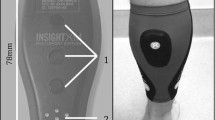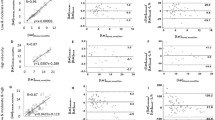Abstract
We determined the ability of gas exchange analyses during incremental exercise tests (IXT) to predict blood lactate levels associated with a range of constant power output cycle ergometer tests. Twenty-seven healthy young men performed duplicate IXT and four 15-min constant power output tests at intensities ranging from moderate to very severe, before and after a training program. End-exercise blood lactate levels were approximated from superficial venous samples obtained 60 s after each constant power output test. From IXT, the power outputs corresponding to peak oxygen uptake (W max) and lactic acidosis threshold (W LAT), were determined. We examined the ability of four measures of exercise intensity to predict blood lactate levels for power outputs above the LAT: (1) power output (W), (2) power difference (W − W LAT), (3) power fraction (W/W max) and (4) power difference to delta ratio [(W − W LAT)/(W max − W LAT)]. Correlation coefficients were r = 0.38, 0.69, 0.75, and 0.81, respectively. The best linear regression prediction equation was: lactate (mmol · l−1) = 12.2[(W − W LAT)/(W max −W LAT)] + 0.7 mmol · l−1. This relationship was not significantly affected by training, despite increased values of LAT and peak oxygen uptake. Normalizing exercise intensity to the range of power outputs between W LAT and W max provided an estimate of blood lactate response to constant power outputs with a standard error of the estimate of 1.66 mmol · l−1.
Similar content being viewed by others
References
Beaver WL, Wasserman K, Whipp BJ (1986) A new method for detecting the anaerobic threshold by gas exchange. J Appl Physiol 60:2020–2027
Buchfuhrer MJ, Hansen JE, Robinson TE, Sue DY, Wasserman K, Whipp BJ (1983) Optimizing the exercise protocol for cardiopulmonary assessment. J Appl Physiol 55:1558–1564
Casaburi R, Oi S (1989) Effect of liver disease on the kinetics of lactate removal after heavy exercise. Eur J Appl Physiol 59:89–97
Casaburi R, Storer TW, Sullivan CS, McKenzie D, Wasserman K (1995) Evaluation of blood lactate elevation as an intensity criterion for exercise training. Med Sci Sports Exerc 27:852–862
Casaburi R, Patessio A, Ioli F, Zanaboni S, Donner C, Wasserman K (1991) Reductions in exercise lactic acidosis and ventilation as a result of exercise training in patients with obstructive lung disease. Am Rev Respir Dis 143:9–18
Farrell PA, Wilmore JH, Coyle EF, Billing JE, Costill DL (1979) Plasma lactate accumulation and distance running performance. Med Sci Sports Exerc 11:338–344
Foster C, Snyder AC, Thompson NN, Kuettel K (1988) Normalization of the blood lactate profile in athletes. Int J Sports Med 9:198–200
Freund H, Oyono-Enguelle S, Heita A, Marbach J, Ott C, Gartner M (1989) Effect of exercise duration on lactate kinetics after short muscular exercise. Eur J Appl Physiol 58:534–542
Hansen JE, Casaburi R, Cooper DM, Wasserman K (1988) Oxygen uptake as related to work rate increment during cycle ergometer exercise. Eur J Appl Physiol 57:140–145
Henson LC, Poole DC, Whipp BJ (1989) Fitness as a determinant of oxygen uptake response to constant-load exercise. Eur J Appl Physiol 59:21–28
Huszczuk A, Whipp BJ, Wasserman K (1990) A respiratory gas exchange simulator for routine calibration in metabolic studies. Eur Respir J 3:465–468
Margaria R, Edwards HT, Dill DB (1933) The possible mechanisms of contracting and paying the oxygen debt and the role of lactic acid in muscular contraction. Am J Physiol 106:689–715
McLellan TM, Gass GC (1989) Metabolic and cardiorespiratory responses relative to the anaerobic threshold. Med Sci Sports Exerc 21:191–198
McLellan TM, Skinner JS (1985) Submaximal endurance performance related to the ventilation thresholds. Can J Appl Sports Sci 10:81–87
Motulsky HJ, Ransnas LA (1987) Fitting curves to data using nonlinear regression: a practical and nonmathematical review. FASEB J 1:365–374
Olsen C (1971) An enzymatic fiuorimetric micromethod for determination of acetoacetate, beta hydroxybuterate, pyruvate, and lactate. Clin Chim Acta 33:293–300
Poole DC, Ward SA, Gardner G, Whipp BJ (1988) A metabolic and respiratory profile of the upper limit for prolonged exercise in man. Ergonomics 31:1265–1279
Rhodes EC, McKenzie D (1984) Predicting marathon time from anaerobic threshold measurements. Phys Sports Med 12:95–98
Ribeiro JP, Hughes V, Fielding RA, Holden W, Evans W, Knuttgen HG (1986) Metabolic and ventilatory responses to steady state exercise relative to lactate thresholds. Eur J Appl Physiol 55:215–221
Roston WL, Whipp BJ, Davis JA, Cunningham DA, Effros RE, Wasserman K (1987) Oxygen uptake kinetics and lactate concentration during exercise in humans. Am Rev Respir Dis 135:1080–1084
Sady S, Katch V, Freedson P, Weltman A (1980) Changes in metabolic acidosis: evidence for an intensity threshold. J Sports Med 20:41–46
Sue DY, Wasserman K, Moricca RB, Casaburi R (1988) Metabolic acidosis during exercise in patients with chronic obstructive pulmonary disease. Chest 94:931–938
Tanaka K, Matsuura Y (1984) Marathon performance, anaerobic threshold, and onset of blood lactate accumulation. J Appl Physiol 57:640–643
Whipp BJ, Ward SA, Wasserman K (1986) Respiratory markers of the anaerobic threshold. Adv Cardiol 35:47–64
Yoshida T, Chida M, Ichaioka M, Suda Y (1987) Blood lactate parameters related to aerobic capacity and endurance performance. Eur J App] Physiol 56:7–11
Author information
Authors and Affiliations
Rights and permissions
About this article
Cite this article
Sullivan, C.S., Casaburi, R., Storer, T.W. et al. Non-invasive prediction of blood lactate response to constant power outputs from incremental exercise tests. Europ. J. Appl. Physiol. 71, 349–354 (1995). https://doi.org/10.1007/BF00240416
Accepted:
Published:
Issue Date:
DOI: https://doi.org/10.1007/BF00240416




